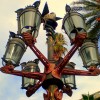Lampposts in Plaça Reial
Plaça Reial
Author: Antoni Gaudí
Materials: wrought iron and limestone
Opening: September 24, 1879
The two six-armed street lights designed by Antoni Gaudí for the Plaça Reial came second to complete the adjustment of the central area of the square, started in 1876 with the installation of the fountain of the Three Graces. The location of lamps on either side of the fountain, following the transverse axis of the rectangle that is the place, not the longitudinal responds to the presence of the main entrance to this area across the street Columbus from Las Ramblas; coming here, streetlights and power we have visually as a whole unit, so that the six radial arms is complemented by a circular sinks source. However Gaudí also introduced the possibility that the lights were four formed a square around the fountain, and so this would have been framed both by accessing from the Rambla, as those who are entering from the street Ferran Madoz through the passage.
But the idea of the architect was able to locate these lights in front of the most significant buildings in the city, including City Hall, the Market, the Old Customs, or even the cathedral, and in public spaces more busy old Barcelona Plaza del Angel, the Pi Sant Josep Oriol, Urquinaona and Portal de l'Angel; Gaudí was the desire to provide greater luminosity to these points, but also enhance them through the beauty of the lanterns.
This variety of possible locations in a way explains the iconography chosen to decorate chandeliers: at the bottom of the column are the shield of the city, emphasis on iron and painted, while the top is crowned by two snakes coiled on which is placed a winged helmet. Snakes come from the caduceus, the symbol of the god Mercury, winged helmet and is also part of the attributes of this deity. Mercury, messenger of the gods, is considered the god of commerce, so it relates to the city of Barcelona.
Although these classical references, the lamps have a completely eclectic character, numerous ornamental details provided by both foot stone and wood as their own arms; These elements provide a flavor "mechanistic" can be found in architects Lluis Domenech i Montaner and Josep Vilaseca in its initial stage. It is also interesting to note the introduction of polychrome, a resource quite rare in these parts, and also corresponds with the basic premises of eclecticism that permeated Catalan architecture from 1875.
-
Gòtic - Pl. Reial
-
Metro
L3 LICEU






